Fat Cat Rockets Hypersonic Transport
Fat Cat Rockets - Hypersonic Transport {Kit}
Contributed by Nick Esselman
| Manufacturer: | Fat Cat Rockets |
![[Picture]](/images/archive/images/ratings/rating_fc_hypersonic.gif) (07/13/02) The Hypersonic Transport is my 2nd
Fat Cat Rockets' rocket. I had also
built the Centaurus prior to Starship Enterprises becoming Fat Cat Rockets. I
bought the Hypersonic Transport for one of the same reasons I built the
Centaurus,
its unique look in a medium to high power rocket. The Hypersonic Transport is
"for those quick trips to the moon or just to the other side of the
planet" according to Fat Cat Rockets and it "will get you there in
style".
(07/13/02) The Hypersonic Transport is my 2nd
Fat Cat Rockets' rocket. I had also
built the Centaurus prior to Starship Enterprises becoming Fat Cat Rockets. I
bought the Hypersonic Transport for one of the same reasons I built the
Centaurus,
its unique look in a medium to high power rocket. The Hypersonic Transport is
"for those quick trips to the moon or just to the other side of the
planet" according to Fat Cat Rockets and it "will get you there in
style".
The Hypersonic Transport is 33" tall and is 3" in diameter. It is designed to fly on 29mm motors with parachute recovery. Fat Cat Rockets indicate that it should weigh 28 ounces without the motor. They recommend G40-5 and G80-7 motors which is nice, as I am a big fan of G80's. (picture courtesy of Fat Cat Rockets until mine gets finished)
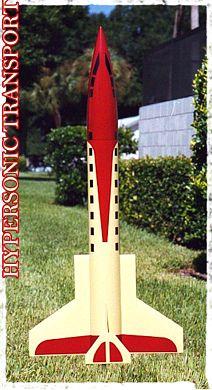 The Hypersonic consists of the main body tube (standard
paper) which is 22½" of 3" diameter with 1/16" wall
thickness. Centering rings (2), Wings (2), Tail (1) are all made from
3/16" plywood. The Wings, including the ram jets, are made up out of ten
(10) pieces of wood, while the Tail is made up of two (2) pieces. There are two
(2) launch lugs that once assembled are hidden inside a ram jet. The motor
mount is 29mm and uses a 8½" tube. The recovery system is beefed up
with a 16" cable that is attached to a 90" piece of 1/2" black
elastic. This is all topped off with a plastic nose cone. My nose cone was
11½" long which made my Hypersonic 34" as opposed to the listed
33" (no big deal to me). Other materials include nose weight (bb's), a
bright-orange 30" rip-stop nylon parachute, a series of detailing stickers
and strips.
The Hypersonic consists of the main body tube (standard
paper) which is 22½" of 3" diameter with 1/16" wall
thickness. Centering rings (2), Wings (2), Tail (1) are all made from
3/16" plywood. The Wings, including the ram jets, are made up out of ten
(10) pieces of wood, while the Tail is made up of two (2) pieces. There are two
(2) launch lugs that once assembled are hidden inside a ram jet. The motor
mount is 29mm and uses a 8½" tube. The recovery system is beefed up
with a 16" cable that is attached to a 90" piece of 1/2" black
elastic. This is all topped off with a plastic nose cone. My nose cone was
11½" long which made my Hypersonic 34" as opposed to the listed
33" (no big deal to me). Other materials include nose weight (bb's), a
bright-orange 30" rip-stop nylon parachute, a series of detailing stickers
and strips.
CONSTRUCTION:
The instructions are printed on one side of a single 8x11" sheet of paper and consist of 6 steps. There are also 6 pages of diagrams including a colored decal placement guide and various templates to help with construction. This rocket is actually fairly straightforward, however, the instructions need some work to make the flow easier. Within the 6 steps, you are referenced to the various other pages to look at figures and templates. Just made the flow a bit difficult. Also, I feel the instructions (words) didn't make one point in particular very clear and of course that is a mistake I made as I will explain below.
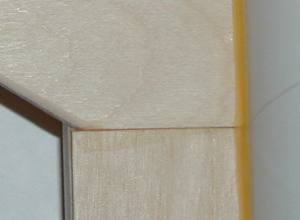 As winter approached here in Vermont, I decided to utilize some of
the last warm days and sand all the leading and trailing edges of the wings and
tail. Fat Cat provides a figure to show you which edges need rounding. Well,
this actually caused a slight problem later. Since the wings are in two pieces
and the ram jets are in three some of this rounding occurred in areas that
wouldn't normally be rounded. Not a big problem, but I had to do a little
filling to clean this up before finishing. Had I followed the instructions and
assembled the wings first, then rounded every thing this wouldn't have
happened. (notice on the left side of the fin where I had rounded the edge
before assembly, this wouldn't have been like this)
As winter approached here in Vermont, I decided to utilize some of
the last warm days and sand all the leading and trailing edges of the wings and
tail. Fat Cat provides a figure to show you which edges need rounding. Well,
this actually caused a slight problem later. Since the wings are in two pieces
and the ram jets are in three some of this rounding occurred in areas that
wouldn't normally be rounded. Not a big problem, but I had to do a little
filling to clean this up before finishing. Had I followed the instructions and
assembled the wings first, then rounded every thing this wouldn't have
happened. (notice on the left side of the fin where I had rounded the edge
before assembly, this wouldn't have been like this)
On the other hand, the instructions have you rounding the edges of the ram jet pieces prior to assembly. I found that they needed work after assembly, too, to make them look good.
Next you use a provided marking guide to draw the lines on the body tube in preparation of cutting the fin slots. Cutting your own fin slots can be somewhat challenging, but please make it easier on yourself and start with a new, sharp hobby knife blade. Spending the 33¢ for a new blade is worth it. Also, don't try to go all the way through on the first pass. I try to merely scribe on the first pass and by the third pass am cutting through.
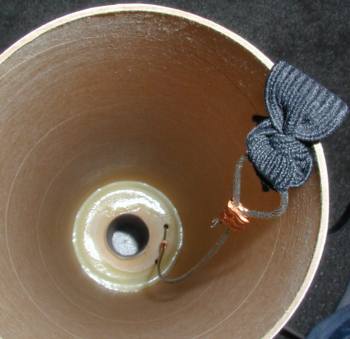 Next the motor mount is
assembled. The upper centering ring has two ¼" holes drilled in it.
The steel cable is threaded through these two holes and crimped. A loop is made
in the opposite end and it too is crimped. The length seems perfect as the
cable just makes it to the top of the airframe.
Next the motor mount is
assembled. The upper centering ring has two ¼" holes drilled in it.
The steel cable is threaded through these two holes and crimped. A loop is made
in the opposite end and it too is crimped. The length seems perfect as the
cable just makes it to the top of the airframe.
The motor mount is then installed into the airframe. You may find it beneficial to pull the shock tether through the motor mount so it doesn't interfere (get coated with glue) while inserting the motor mount. I tested a new trick while installing this motor mount. What I did was to place a fairly large amount of glue on the upper side of each of the centering rings about 1/8" from the edge. I then pushed the motor mount into the airframe until it was 1/4" from its final position. Then by holding the airframe horizontally and slowing turning it, allowed the glue to flow off the edge of the centering ring to meet the airframe. Slowly turning it allowed for it to meet all the way around. I could visually see this happening on the upper centering ring by looking down the airframe from the top. Once touching all the way around, I then pushed the motor mount up that final 1/4" into position and sat it on its end to dry. You need a glue that is strong and will flow initially. I figure 1-hour epoxy would work, or what I used: ProBond Polyurethane Glue which worked great! (additional comments about ProBond Polyurethane glue)
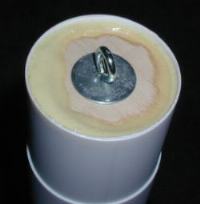 The nose weight (BB's) is epoxied into the nose cone next. The
nose cone came without a bottom allowing the nose weight to be added very
easily. After the epoxy (or in my case the polyurethane glue) is dry, the
bulkhead is assembled in the shoulder of the nose cone. The nose cone was
fairly loose in the airframe which required two layers of masking tape to snug
up.
The nose weight (BB's) is epoxied into the nose cone next. The
nose cone came without a bottom allowing the nose weight to be added very
easily. After the epoxy (or in my case the polyurethane glue) is dry, the
bulkhead is assembled in the shoulder of the nose cone. The nose cone was
fairly loose in the airframe which required two layers of masking tape to snug
up.
Oh, yes, my one big mistake. After cutting the slots in the airframe for the wings and tail I followed the instructions to assemble the wings to the airframe. After they were dry, I applied glue and inserted the tail into the remaining slot in the tube. As I was sitting there looking at it, it didn't seem to me to be a stable design as the ram jets were on top along with the tail. While thinking this I sorted through all the pages of diagrams and noticed that I had installed the wings upside down. So I pulled the tail out before the glue set. I cut a new slot on the opposite side, filled the old slot with the original piece of tubing that was removed, and glued the tail into the new slot. Much better. I guess I should have caught that earlier, however, I feel the instructions should have helped me help myself.
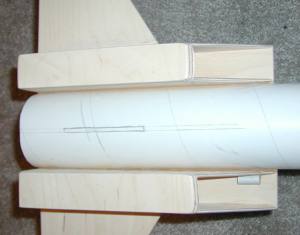 Due to winter in Vermont, I have not been able to finish
the Hypersonic Transport. The instructions provide a good description for
finishing and provides a set of detailing tape. So I will add more information
once I can finish and fly this rocket. Stay tuned . . .
Due to winter in Vermont, I have not been able to finish
the Hypersonic Transport. The instructions provide a good description for
finishing and provides a set of detailing tape. So I will add more information
once I can finish and fly this rocket. Stay tuned . . .
Overall, for CONSTRUCTION I would rate this kit 4 points. I found the quality of the parts to be excellent, the rocket design's uniqueness is great, and the fit of all the components was perfect. The instructions need to be enhanced to be clearer and flow better. This should not be someone's first mid-power kit, but it should be one of the choices for getting away from 3-Fin-Nose-Cone type rockets.
FINISHING:
As you can see, I went away from the Fat Cat color scheme. I wanted to try my hand at this special DupliColor Mirage paint. I picked up a kit from Walmart. The Purple/Green variety. After that, I didn't think the detailing tape had the look I wanted, so I cut my own decals from some extra vinyl ones that came with a special BSD Thor order. I think it came out okay. I used much of the information for the windows from the provided instructions.
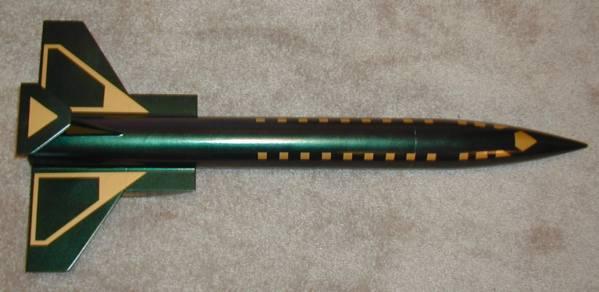
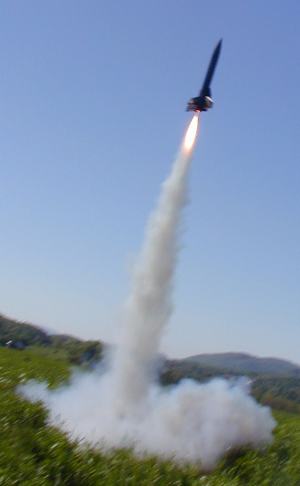 FLIGHT/RECOVERY:
FLIGHT/RECOVERY:
Fat Cat recommends two motors, the G40-5 and G80-7. In addition, their stated finished weight is 28 ounces.
Now, in my case, I only had a couple of G64-4's and my finished weight was 29.5 ounces, so I felt we had a good match!
I was so excited one day in May when I woke up and it was perfectly calm and beautiful. So I went flying! I loaded the Hypersonic Transport with my RMS G64-4. I had failed to add any positive motor retention (and none comes with the kit) so I risked it and did a friction fit of my RMS casing. The hope was to see it again.
The rocket looked great sitting there on the rod with the hidden launch lugs. I gave a count down and varrrrroooommmmm. Off she went. Beautiful. The flight was very straight and stable. The ejection was a bit early, probably could have waited another second or so, but the bright-orange 30" rip-stop nylon parachute deployed and descended very nicely. Not too fast and not too slow.
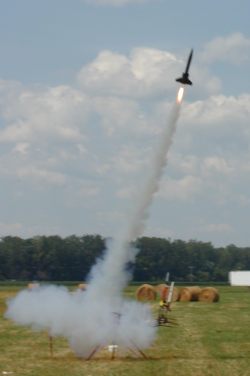 With such a nice flight I was looking forward to my next launch
and NYPower 2002. I loaded the same motor, G64-4, and set it up on the middle
row of pads. It was rather windy this day so we had about a 10 degree rod
angle, but I still was not worried. Upon ignition though, the Hypersonic
Transport appeared to lose its spaceship-like qualities and more resembled a
wounded duck. It was flying in the right direction, but seemed as if the wind
would push it, the fins corrected it, push, correct, push, correct . . . then
turned back toward the ground then ejection. Very scary.
With such a nice flight I was looking forward to my next launch
and NYPower 2002. I loaded the same motor, G64-4, and set it up on the middle
row of pads. It was rather windy this day so we had about a 10 degree rod
angle, but I still was not worried. Upon ignition though, the Hypersonic
Transport appeared to lose its spaceship-like qualities and more resembled a
wounded duck. It was flying in the right direction, but seemed as if the wind
would push it, the fins corrected it, push, correct, push, correct . . . then
turned back toward the ground then ejection. Very scary.
The 'chute opened and it carried right on over to hit the porta-potty door. Scared the women going inside, but no damage at all.
I bounced this information off of the folks at Fat Cat Rockets and got a couple of interesting thoughts back. Since the first flight was stable and no changes were made the rocket appears to have been built correctly (if was) and was stable, therefore, stability factures would need to be outside of the rocket. I gave thought to the wind however, they assured me they have experience with it flying well in the wind AND from my own observations with other flights the wind doesn't do this push, correct thing it would simply push it over more and more horizontal. So what else? Motor and rod length were discussed. I inspected the motor and they may have a point. As I inspected the nozzle I did notice a build up on one side behind and in the throat. Also the way the residue was in the motor casing to one side. I can't say for sure as I lack experience in this but there are some clues. So time and more flights will tell!
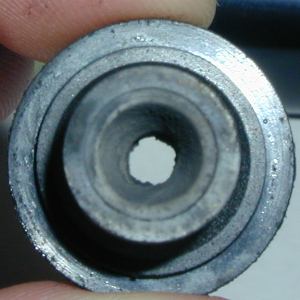
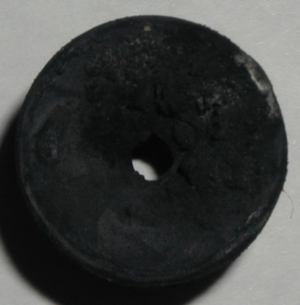
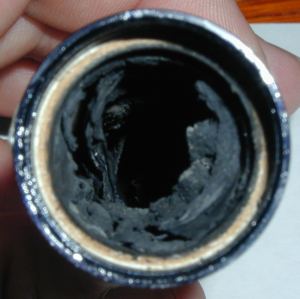
For FLIGHT/RECOVERY I would rate this kit 3 points. I found the looks and flight silhouette to be excellent. The recovery system is very nice and brings the rocket in nicely. Keep an eye on the elastic shockcord though. The kit also needs positive motor retention (I know, I know, most mid to high power kits don't have it, but....). Regardless of my second flight, my gut feel is that this is a stable flying rocket and I look forward to future flights to prove that.
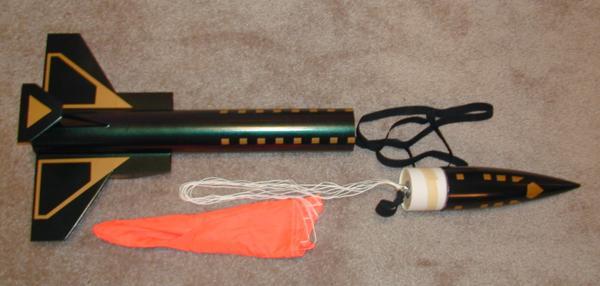
If you are looking for a medium-sized rocket with some unique looks and quality components, then the Hypersonic Transport is for you. Solid construction and a great flight silhouette. You may be limited to the days you can actually fly it (calm) but it will definitely get the attention of observers. On G's, it is not a terribly high flier either, so this will be nice for smaller fields. Overall, I would rate this kit 3 ½ points.
 |
 |